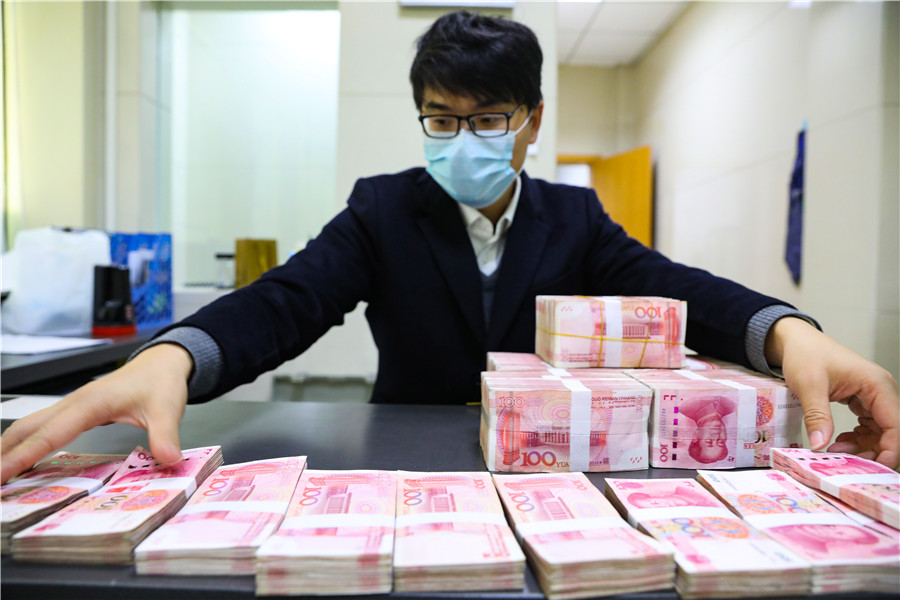Situation ripe for expansionary fiscal, monetary policies


As the spread of the novel coronavirus disease is now under control in China, the government should consider launch of forceful expansionary fiscal and monetary policies to stimulate economic growth.
Before the pandemic broke out, a view widely accepted by the government and economic circles was that China's potential gross domestic product or GDP growth will be around 6 percent this year. Owing to a 6.8-percent year-on-year decline in first-quarter GDP, if the country could realize a 6-percent growth in the remaining three quarters, its GDP growth would still reach 3.2 percent this year.
However, if external demand keeps weakening and the rebound in consumption is barely satisfactory, whether or not the Chinese economy could expand by 3.2 percent or an even higher rate this year will depend on whether the capital formation growth rate will increase substantially. And the capital formation growth rate will depend on the increase of investment in areas such as manufacturing, real estate and infrastructure.
Given the present circumstances of insufficient effective demand, to ensure GDP growth of more than 3 percent, China must boldly carry out expansionary fiscal policy, which should be supplemented by expansionary monetary policy.
According to initial estimates by my colleagues at the Institute of World Economics and Politics, which is part of the Chinese Academy of Social Sciences, this round of expansionary policy should increase the volume of infrastructure investment by a lot more than 4 trillion yuan ($563 billion), which was the value of a stimulus package introduced by China to counteract the effects of the 2008 Global Financial Crisis.
Our estimates also show that during the last three quarters of this year, the growth of infrastructure investment must be well above GDP growth.
Furthermore, the government should continue to spend on coronavirus bailouts in many areas after the pandemic is brought under reasonable control and the industries have fully resumed production. In particular, the government should provide assistance to those who have lost their jobs because of the pandemic but are not covered by the social security system.
Some export-oriented companies may face severe challenges due to the changing landscape of global trade. They have to transition from relying mainly on external demand to relying mainly on domestic demand. Under the circumstances, the government may need to create an item of expenditure to help these companies get through hard times during the transition.
While fiscal expenditure may increase substantially, China's fiscal revenues will decline significantly due to an economic slowdown and the implementation of tax cuts and fee reductions. This will inevitably lead to a sharp increase in the deficit-to-GDP ratio.
Many people do not support the idea that the government must launch policies that are similar to the 4 trillion yuan stimulus package in 2008, for they are worried that fiscal deficit may rise too fast and could therefore lead to a further increase in the government debt leverage.
Such concerns are not completely unreasonable, but they are not enough for us to conclude that China should not implement a fiscal policy which is more expansionary this year than it was last year.
It is worth noting that the debt situation of the Chinese government is better compared with that of many other countries, especially major developed countries.
From 2008 to 2017, the average deficit-to-GDP ratio was 3.5 percent in the European Union, 6 percent in the United Kingdom, 6.8 percent in Japan, 6.7 percent in the United States and 7.8 percent in India. During the same period, the average deficit-to-GDP ratio was less than 2 percent in China.
Besides, China's public debt-to-GDP ratio is no more than 50 percent, even if we take local government debt into consideration. This number is lower than that of most countries.
Excessively high leverage of government debt will raise concerns because creditors will be worried that debtors cannot repay debts as agreed, so they will stop providing financing, which will eventually lead to a sovereign debt crisis.
However, that problem does not exist in China as the country's savings rate is one of the highest in the world, and Chinese residents want to have more financial assets, of which national debt is the safest.
Because of high demand for national debt, the government has no problem to pay off old debts by issuing new debt at a relatively low cost, not to mention that the huge amount of State-owned assets is far beyond the outstanding balance of national debt.
If we look at government debt leverage from a dynamic perspective, we will find that improving GDP growth is the most important way of leverage reduction.
From the end of the 1990s to the beginning of the 21st century, China's financial situation improved mainly because the country increased economic growth by adopting expansionary fiscal policy.
In the first quarter of this year, the national general public budget revenue fell 14.3 percent year-on-year, while the national general public budget expenditure dropped only 5.7 percent. As a result, the deficit-to-GDP ratio was 4.5 percent in the first quarter, up from the projected ratio of 2.8 percent last year.
Obviously, China's financial situation worsened sharply in the first quarter because fiscal revenues declined too fast, which was mainly caused by a slowdown in economic growth. In order to improve the financial situation, China must increase economic growth. If the country further cuts government spending, however, we will see further economic slowdown.
As long as a country has high savings rates, high leverage will not trigger financial risks. Instead, it is a prerequisite for achieving rapid economic growth, as producers will borrow money from households via the lending and bond markets to make investments.
Infrastructure investments paid by the government will lead to a large number of orders for relevant companies, especially privately held small and medium-sized enterprises. As their output increases, corporate leverage will decline correspondingly.
China's corporate debt-to-GDP ratio is high. The ratio went up in part because of the 4 trillion yuan stimulus package announced in 2008. At that time, the money for infrastructure projects was primarily raised by local government financing vehicles, for the central government did not want to see an excessively rapid increase in the deficit-to-GDP ratio.
The central government would do well to raise funds for infrastructure projects by issuing national debt, to make fiscal deficit and government debt explicit.
While advocating the adoption of expansionary fiscal policy, we must be highly alert to various types of wastage of money and must strongly resist vanity projects and white elephant projects, which refer to financial endeavors that cost a great deal of money but fail to live up to their expectations.
The government should ramp up support for infrastructure investments and strictly enforce economic discipline at the same time. Even after officials and project leaders leave their posts, they should still be held accountable for any possible wastage of public funds.
The writer is an academician with the Chinese Academy of Social Sciences in Beijing.




































